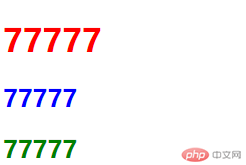选择器id、class、tag
优先级id>class>tag
示例
<!DOCTYPE html><html lang="en"><head> <meta charset="UTF-8"> <title>Document</title> <style type="text/css"> /* id选择器,优先级大于class与tag,h1为红色*/ h1#p11.p1{color: red} h1.p1{color: blue} h1{color: green} /* class选择器,优先级大于tag,h2为蓝色*/ h2.p2{color: blue} h2{color: green} /* h3为绿色*/ h2{color: green} </style></head><body> <h1 class="p1" id="p11">77777</h1> <h2 class="p2" id="p22">77777</h2> <h2 class="p3" id="p33">77777</h2></body></html>
效果如图

简单的前端组件样式模块化
dome.html
<!DOCTYPE html><html lang="en"><head> <meta charset="UTF-8"> <title>Document</title> <!--引入文件index.css--> <link rel="stylesheet" type="text/css" href="css/index.css"></head><body> <header>首</header> <main>身</main> <footer>尾</footer></body></html>
index.css
@import url(header.css);@import url(main.css);@import url(footer.css);
header{min-height: 3em;background-color: red;}
main.css
nain{min-height: 5em;background-color: blue;}
footer{min-height: 4em;background-color: green;}
伪类选择器的使用
deom.html
<!DOCTYPE html><html lang="en"><head> <meta charset="UTF-8"> <title>Document</title> <link rel="stylesheet" type="text/css" href="css/css.css"></head><body> <ul class="list"> <li>7777</li> <li>7777</li> <li>7777</li> <li>7777</li> <li>7777</li> <li>7777</li> </ul> <ul> <li>888</li> </ul></body></html>
css.css
/*第一个li*/.list > li:first-of-type { background-color: red;}/*第二个li*/.list > li:nth-of-type(2) { background-color: yellow;}/*最后一个li*/.list>li:last-of-type{ background-color: blue;}/*倒数第三个li*/.list>li:nth-last-of-type(3){ background-color: green;}li:only-of-type{ background-color: skyblue;}
效果如图




